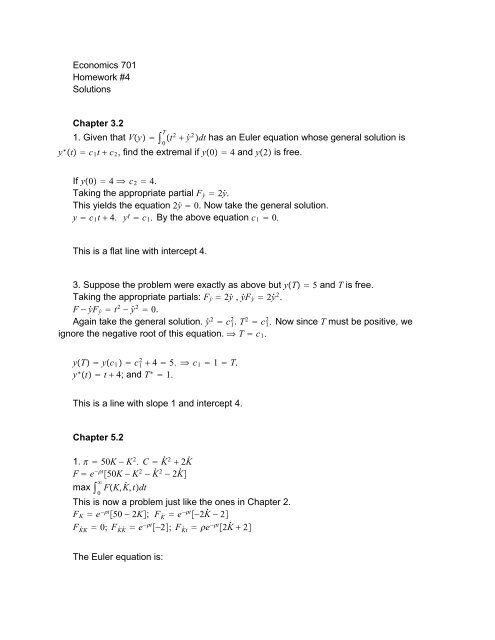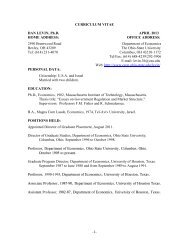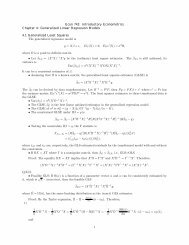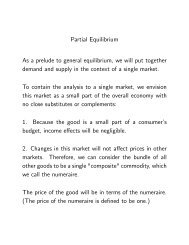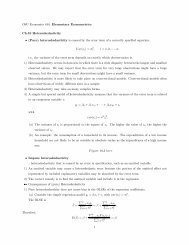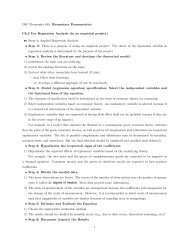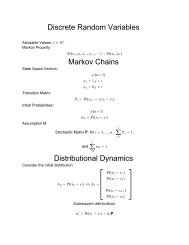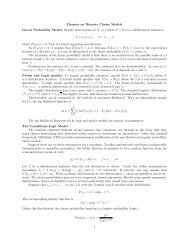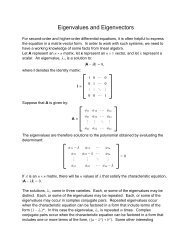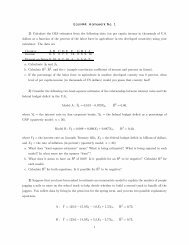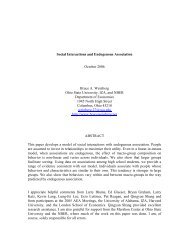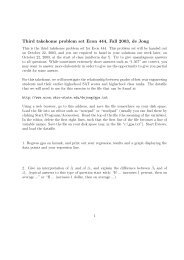Economics 701 Homework #4 Solutions Chapter 3.2 1. Given that V ...
Economics 701 Homework #4 Solutions Chapter 3.2 1. Given that V ...
Economics 701 Homework #4 Solutions Chapter 3.2 1. Given that V ...
Create successful ePaper yourself
Turn your PDF publications into a flip-book with our unique Google optimized e-Paper software.
<strong>Economics</strong> <strong>701</strong><br />
<strong>Homework</strong> <strong>#4</strong><br />
<strong>Solutions</strong><br />
<strong>Chapter</strong> <strong>3.2</strong><br />
T<br />
<strong>1.</strong> <strong>Given</strong> <strong>that</strong> V!y" ! ! !t 2 " y# 2 "dt has an Euler equation whose general solution is<br />
0<br />
y " !t" ! c 1 t " c 2 , find the extremal if y!0" ! 4 and y!2" is free.<br />
If y!0" ! 4 # c 2 ! 4.<br />
Taking the appropriate partial F y# ! 2y# .<br />
This yields the equation 2y# ! 0. Now take the general solution.<br />
y ! c 1 t " 4. y$ !c 1 . By the above equation c 1 ! 0.<br />
This is a flat line with intercept 4.<br />
3. Suppose the problem were exactly as above but y!T" ! 5 and T is free.<br />
Taking the appropriate partials: F y# ! 2y# , y# F y# ! 2y# 2 .<br />
F # y# F y# ! t 2 # y# 2 ! 0.<br />
Again take the general solution. y# 2 ! c 1 2 . T 2 ! c 1 2 . Now since T must be positive, we<br />
ignore the negative root of this equation. # T ! c 1 .<br />
y!T" ! y!c 1 " ! c 1 2 " 4 ! 5. # c 1 ! 1 ! T.<br />
y " !t" ! t " 4; and T " ! <strong>1.</strong><br />
This is a line with slope 1 and intercept 4.<br />
<strong>Chapter</strong> 5.2<br />
<strong>1.</strong> ! ! 50K # K 2 . C ! K# 2 " 2K#<br />
F ! e #"t $50K # K 2 # K# 2 # 2K# %<br />
$<br />
max ! F!K,K #<br />
0<br />
,t"dt<br />
This is now a problem just like the ones in <strong>Chapter</strong> 2.<br />
F K ! e #"t $50 # 2K%; F K # ! e #"t $#2K# # 2%<br />
F K # K ! 0; F K # K# ! e #"t $#2%; F K # t ! "e #"t $2K# " 2%<br />
The Euler equation is:
2<br />
#2e #"t K% " "e #"t $2K# " 2% # e #"t $50 # 2K% ! 0.<br />
#2K% ""$2K# " 2% # $50 # 2K% ! 0<br />
K% # "K# # " " 25 # K ! 0<br />
K% # "K# # K ! " # 25<br />
Begin by finding the homogenous solution:<br />
K% # "K# # K ! 0<br />
characteristic equation: r 2 # "r # 1 ! 0.<br />
r ! " & "2 " 4<br />
. Let r<br />
2<br />
1 ! " " "2 " 4<br />
; Let r<br />
2<br />
2 ! " # "2 " 4<br />
2<br />
The general solution is K ! c 1 e r1t " c 2 e r 2t<br />
For the particular solution conjecture a constant solution.<br />
K' ! 25 # ". Note <strong>that</strong> this holds.<br />
K " !t" ! c 1 e r 1t " c 2 e r 2t " K' .<br />
Two boundary conditions:<br />
TC: lim t($<br />
F # K# F K # !K!t",K# !t",t" ! 0 # c 1 ! 0. This is because r 1 is positive, and it is the<br />
explosive root.<br />
Let K!0" ! K 0 .<br />
K 0 ! c 2 " 25 # ". # c 2 ! K 0 # 25 " ".<br />
K " !t" ! !K 0 # 25 " "" exp<br />
" # " 2 " 4<br />
2<br />
t " 25 # ".<br />
3. The problem from 5.13 is<br />
$<br />
max )!K" ! ! $!!K" # C!K # "%e #"t dt<br />
0<br />
s.t. K!0" ! K 0 , given.<br />
F K ! e #"t ! $ !K"<br />
F K # ! #e #"t C $ !K# "<br />
F K # K# ! #e #"t C $$ !K# "<br />
F K # K ! 0.<br />
F K # t ! "e #"t C $ !K# "<br />
After dividing through by #e #"t , the Euler equation is:<br />
K% $C $$ !K# "% # "C $ !K# " " ! $ !K" ! 0


